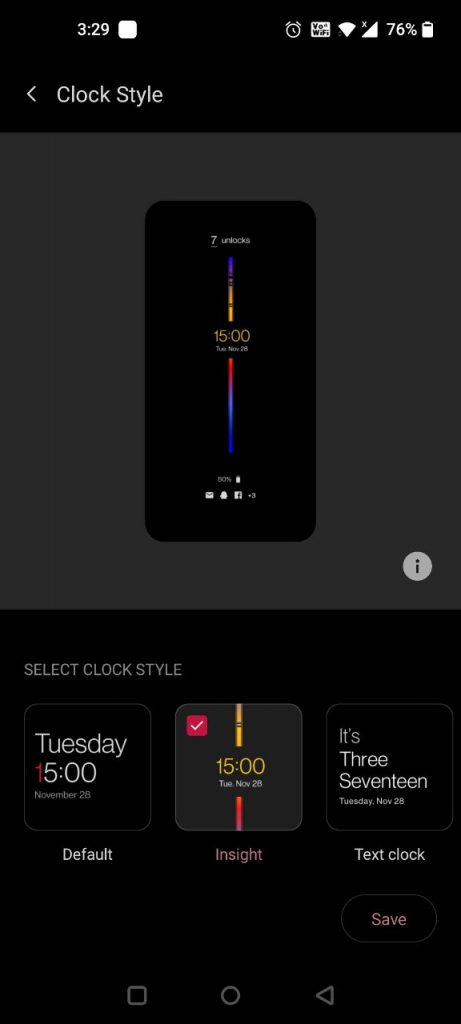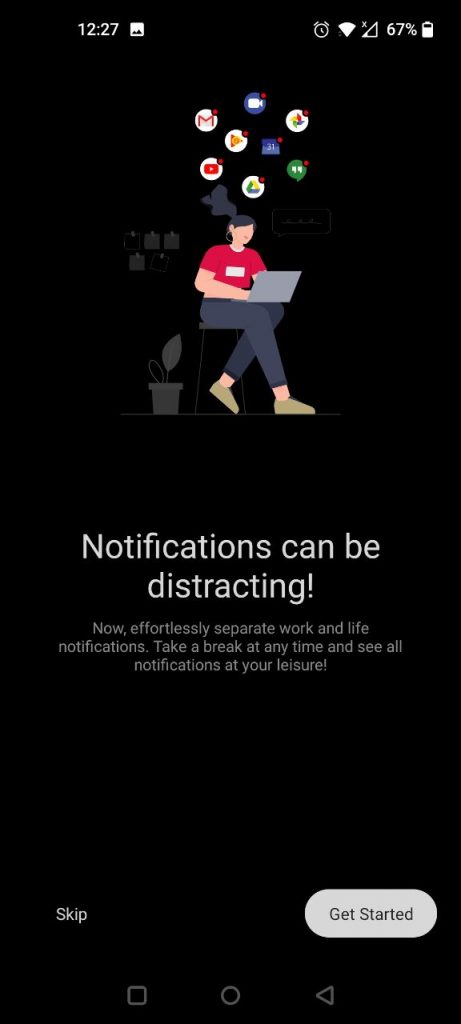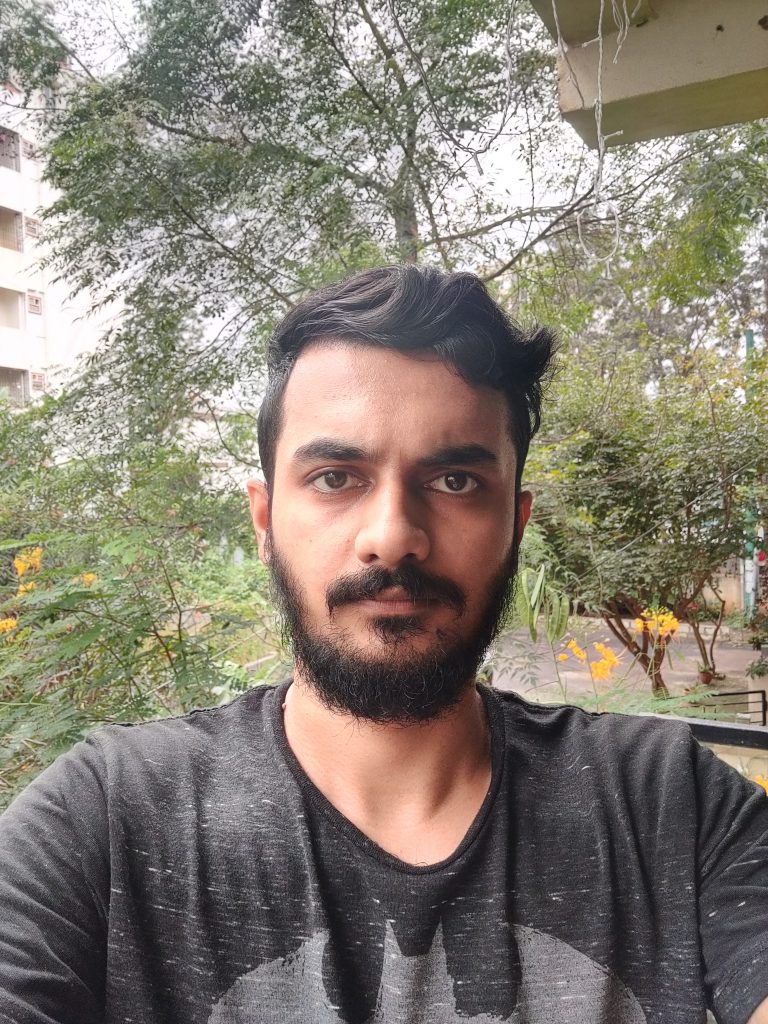
Keeping up with the tradition, OnePlus launched the ‘T’ version of the OnePlus 8 series in India a few weeks back. The OnePlus 8T is similarly spec’d as its predecessor, but, it carries few upgrades too – 65W charger, a 200mAh battery bump-up, 5MP macro camera, 2MP depth camera and 120Hz display. However, the upgrades becomes meaningful only if it’s implemented right.
How good is the OnePlus 8T? We have jotted down the reason on why you should and should not buy. Check it out!
Why should you buy OnePlus 8T?
Design and display – No compromise as usual

Following OnePlus over the years, I can safely say that they don’t compromise on build quality. At 188 grams, the device is absolutely lightweight and feels compact. Like its predecessor, the OnePlus 8T also comes with glass build on both front and back with aluminum frames on sides with Matt finish. With 8.4 mm thickness, the device feels really sturdy and well-built. We got the Aquamarine Green color variant.
On to the design, the traditional vertical camera module has been replaced with a squarish-oval camera module and it has been pushed to the left corner as well. On the front, it retains the same punch hole camera like OnePlus 8. The button’s feedback is on point including the alert slider. Overall, OnePlus hasn’t done much on the design (except few refining) and feels familiar to its predecessor.
The OnePlus 8T sports a 6.55-inch (2400 x 1080 pixels) Full HD+ 20:9 aspect ratio Fluid AMOLED display with 120Hz refresh rate. The display is protected by 3D Corning Gorilla Glass. The ‘Fluid AMOLED’ display, as OnePlus labels it, is purely due to the 120Hz refresh rate that it supports. It supports HDR10+ sRGB color gamut and DCI-P3 color gamut. The colors are vibrant, blacks are deep, have a very good peak brightness at 1100 nits (so you will be fine under direct sunlight) and the content consumption are excellent, thanks to dual firing speakers.
At 120Hz, the OnePlus 8T feels smoother and faster while scrolling through my social media feeds and paging through home screen felts snappier. However, the battery drains a bit faster if you use it on 120Hz all the time.
So you have the option either to choose 60Hz or 120Hz. There are options to calibrate the screen with three options – Vivid, Natural, and Advanced. In case, if you read a lot on-the-go, Reading Mode – Chromatic effect and Mono effect, serve you the best. Like its predecessor, we also have a ‘punch-hole’ hiding option. OnePlus has added a gimmicky feature in the device – “Vibrant Color Effect”, which punches up the colors upon enabling. One of the best parts of Android 11 is its Gestures and Navigation.
OxygenOS – Moving away from Stock

The OnePlus 8T is shipped with Android 11 with OxygenOS 11 on top. OxygenOS 11 is the biggest overhaul in the history of OnePlus’ OxygenOS. This time, OnePlus took inspiration from Samsung’s OneUI with a design more focussed on one-handed usage. However, the new design language is only built into a handful of apps.
With OxygenOS 11, we also the got the much awaited ‘Always-On’ display and it is implemented perfectly. The company has also added a new ambient display feature called ‘Canvas,’ that automatically draw a wireframe picture based on a lock screen photo on your phone. Canvas can be accessed by going to Settings -> Customisation -> Wallpaper -> Canvas -> Choose photo.
Coming to the customisation options, there are options to change accent colors, shapes of quick toggles, font styles, and icon packs. Other useful features include double tap to lock, and Launcher layout (where you can select Homescreen with App drawer or just the home screen that accommodates all apps). And there is a ‘Left most screen’ option, where you can choose to have Google news feed or OnePlus Shelf.
The Live Caption feature detects speech in media and automatically generates caption. Right now it works well with English content, and we can expect it in other languages soon. As per the company claims, this feature uses additional battery. Also, there are ways to move around and expand the caption. The Live Caption can be turned on and off through volume rockers as well. The Dolby Atmos offer three scenario-based enhancement — Dynamic, Movie, Music. It also has separate “Earphone Adjustment”, where you can play with equaliser and audio styles.
Talking about the Earphones, there is an “Earphone Mode” where you can enable a slew of options as you can from the above screenshots. These options come handy especially when you commute by bike or car.
Yet another new feature here is “Optimized charging” where it optimises charging patterns according to your usage habits to reduce battery load and extend battery life. There are options to enable dark tone in more apps as well. It enforces the dark mode in third-party apps that don’t support it.
With OnePlus 8T Series, there is an option to select the function of power keys — Power menu or Voice Assistant. There is a “Work-Life Balance” feature that categorises the notification you’d want to be notified by. This feature can be enabled with apps, Wi-Fi networks, location, and timings too.
Performance — No compromise!

The OnePlus 8T is powered by the latest Octa-Core Qualcomm Snapdragon 865 7nm Mobile Platform with Adreno 650 GPU under the hood. This chipset support 5G and has a dedicated X55 modem.
Just like it’s predecessor, the OnePlus 8T is incredibly fast and continues to do what it is best at. In our experience, we experienced zero lag, zero hitches, and it’s just pure speed and raw power. The read/write speed is more rapid, with UFS 3.0 storage.
Check out some synthetic benchmark scores below.
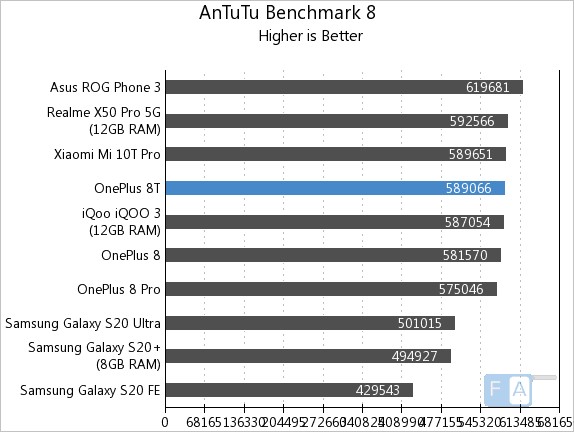


On the multimedia front, the OnePlus 8T comes with the stereo speakers with the primary loudspeaker facing downwards and the secondary speaker doubles as the earpiece. It supports Dolby Atmos certification as well. The audio output across all the levels are enjoyable without much distortion at the higher volumes. The sound quality through headphones comes out neat without any complaints.
Battery life — Yay for casual users!

The OnePlus 8T is powered by a bigger 4500mAh battery with Warp Charge 65W technology. The company has bumped an extra 200mAh, considering the apparent reasons — 120Hz refresh rate. On a casual usage, we got around 5:45 to 6 hours of screen on time on 120Hz. But falls considerably on heavy usage. Switching back to 60Hz gives you extra battery life!
It achieved One Charge Rating of 18 hours and 58 minutes, which is slightly better than the OnePlus 8 since it has a slightly bigger battery. This is in 60Hz refresh rate, so it should be less in 120Hz.
In general, the Warp Charge 65 charges the device quickly, and that sort of makeup for the fact that it doesn’t have the convenience of wireless charging. The 65W technology charges the device from 0 to 100% in just 39 minutes.
What could have been better?
Camera — Not up to the mark
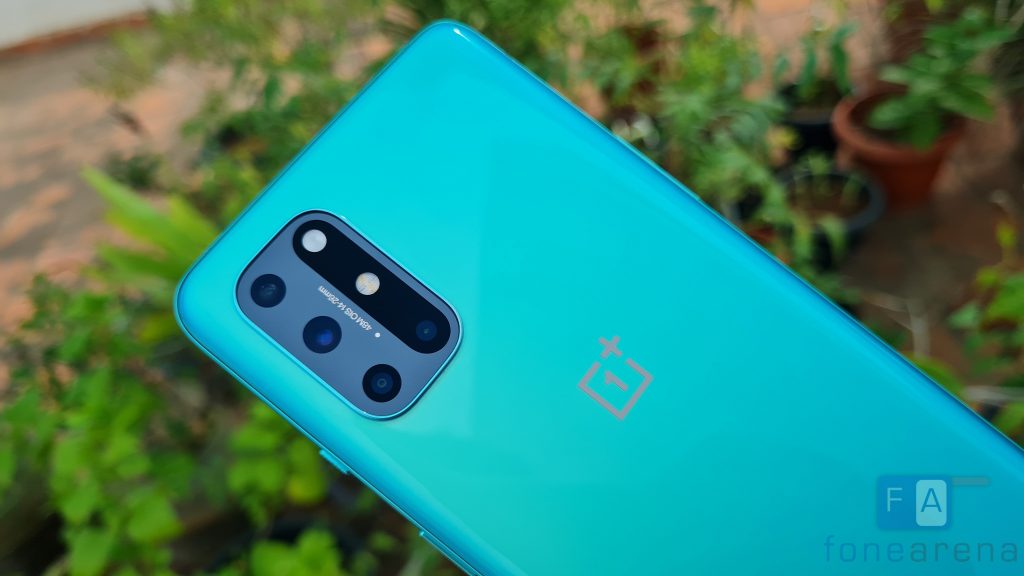
The OnePlus 8T comes with a quad-camera setup
- Primary – 48MP rear camera with Sony IMX586 sensor, 0.8μm pixel size, f/1.75 aperture, OIS + EIS Hybrid stabilisation.
- Secondary – 16MP 116° ultra-wide camera with f/2.2 aperture.
- Third – 5MP macro camera with f/2.4 aperture.
- Fourth – 2MP depth sensor
- Video capability – 4K video at 60 fps, 720p slow motion at 480fps, 1080p slow motion at 240fps
- Front camera – 16MP front-facing camera with Sony IMX471 sensor, f/2.45 aperture, EIS
Well, not much has changed from the OnePlus 8, be it camera specification or quality of the image. As a successor, the OnePlus 8T brings just an extra 2MP depth camera, bumped up 5MP macro camera and that’s about it.
Talking about the usage, the primary camera captures very good photos with fine details. Most of the time, pictures churned out from the main sensors were sharp, had good colors and accurate exposure.
The wide-angle camera also performs as expected. Portrait mode works well. The 5MP macro, in our experience, wasn’t great after all. We had focus issues, details aren’t that impressive. Since it doesn’t have a dedicated optical zoom sensor, anything beyond 2X produces noise and not recommendable.
Coming to the low-light condition, the OnePlus 8T camera produces images that are brighter than reality even without Nightscape mode. But the half of the details are not retained. Enabling the Nightscape brings details from shadows and offers the right amount of sharpness as well. Overall the difference is very minimal when it comes between a regular photo and with Nightscape.
The front camera produces some decent images in the daylight, portrait works well with right edge detection half of the times, exceptions are there though. Under low-light, the performance of the camera is purely average and it depends upon the light too.
In terms of videography, the 4K offers a good, stabilised output with good color retention. There are options to switch between the main camera and wide-angel in between video, but it works only up to 4K 30 FPS.
Macro
Other mentions

The OnePlus 8T supports connectivity options including 5G SA/NSA, Dual 4G VoLTE, Wi-Fi 6 802.11 ax 2X2 MIMO, Bluetooth 5.1, GPS (L1+L5 Dual Band) + GLONASS, USB Type-C. The in-display scanner is snappy and fast, one of the best in the market at present. The call quality over earpiece and headphones is excellent as well.
Competition
At this price point, OnePlus 8T is surrounded by numerous power-packed competitors like iQOO 3, Mi 10T Pro, Samsung Galaxy S20 FE, Pixel 4a, including its sibling OnePlus 8.
Price and availability
The OnePlus 8T comes in Aquamarine Green and Lunar Silver colours, is priced at Rs. 42,999 for the 8GB RAM with 128GB storage version and the 12GB RAM with 256GB storage version costs Rs. 45,999.
It is available on Amazon.in, oneplus.in, OnePlus Store App, OnePlus exclusive offline stores and partner outlets.


